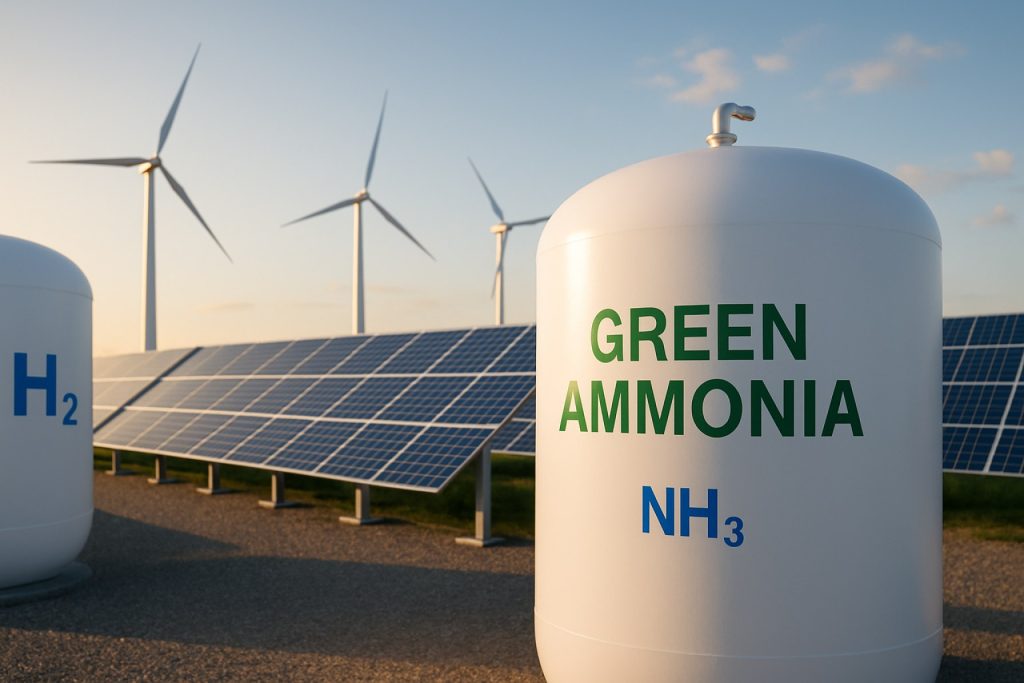
- A landmark India-Germany alliance is launching a major green ammonia plant at Mulapeta Port, Andhra Pradesh.
- The facility will produce 1 million tonnes of green ammonia annually, using 180,000 tonnes of renewable green hydrogen.
- Green ammonia, made without fossil fuels, will help decarbonize industries like fertilizers, shipping, and steel.
- This project combines Germany’s engineering and India’s renewable resources, reinforcing global cooperation for clean energy.
- India’s growing investment in renewables and Germany’s expertise are key to accelerating the global clean hydrogen revolution.
- Efforts like this aim to supply carbon-neutral fuels worldwide, advancing climate change solutions and the net-zero agenda.
A new chapter is unfolding on the sun-soaked coastline of Andhra Pradesh, where the ambitions of Indian and German innovators are converging to shape the future of green energy. Sleek pipelines will soon snake toward the shore at Mulapeta Port, channelling not oil or gas, but green ammonia—a chemical poised to become a linchpin of the world’s decarbonization efforts.
At the heart of this alliance lies a bold pact between India’s Juno Joule Green Energy and Germany’s SET Select Energy, along with its sustainable arm, Select New Energies. The collaboration was sealed with a handshake at the World Hydrogen Summit in Rotterdam, signaling a shared vision that transcends continents and business cultures. Their blueprint? To construct one of the world’s most advanced facilities, capable of producing an astonishing 1 million metric tonnes of green ammonia every year. This output will draw from approximately 180,000 tonnes of green hydrogen—hydrogen produced in an environmentally responsible manner, split from water using renewable power.
Unlike conventional ammonia, typically manufactured using fossil fuels, green ammonia promises to slash emissions in industries notorious for their carbon footprints. Fertilizer giants, maritime shippers, and steel manufacturers are all eyeing green ammonia as a key to unlocking cleaner operations. By leveraging the renewable potential of India’s east coast—where steady winds and blazing sunlight make green hydrogen production especially efficient—this project aims not just for local impact, but for a global ripple effect.
Germany’s expertise in precision engineering and sustainable project development blends seamlessly with India’s burgeoning renewable ecosystem and government support for clean energy initiatives. Together, the partnership underscores a critical truth: No single country holds a monopoly on the future of energy. Instead, the green transition relies on the free flow of technology, investment, and expertise across borders.
For India, which recently set a 2070 net-zero target and rapidly expanded funding for renewable energy programs, this collaboration affirms its place on the front lines of the clean hydrogen revolution. For Germany, struggling to diversify energy sources while reducing reliance on fossil imports, Indian collaboration offers both a market and a proving ground for its pioneering eco-technologies.
As vessels prepare to dock at Mulapeta, the dream of shipping carbon-neutral fuels from Indian shores to global markets edges closer to reality. This is more than an energy venture—it’s a statement of possibility. Green ammonia may soon fuel not just crops and cargo ships, but the very momentum needed to slow climate change itself.
Takeaway: Major international alliances like this are accelerating the adoption of clean energy solutions across domains where decarbonization once seemed impossible. Projects like the Mulapeta green ammonia facility are blueprinting a new industrial age—one powered by collaboration, ingenuity, and unwavering commitment to a greener planet.
Green Ammonia Revolution: What India’s Andhra Pradesh Project Really Means for the World (And You!)
A Deep Dive Into the Game-Changing Indo-German Green Ammonia Project
India and Germany are making headlines by launching one of the world’s most ambitious green ammonia projects at Mulapeta Port, Andhra Pradesh. But beyond the basic announcement, what does this project mean for global energy, the climate crisis, industries, and individuals? Here’s the untold story—with key facts, market trends, controversies, and quick life hacks for readers wanting to surf the clean energy wave.
—
What Is Green Ammonia—And Why Now?
Green ammonia is produced by using green hydrogen (made from renewable energy) and nitrogen, eliminating the carbon emissions associated with traditional ammonia production. This is vital because ammonia, mostly used as fertilizer and in industry, currently accounts for roughly 2% of global energy consumption and about 1% of total greenhouse gas emissions (Source: IEA).
Key Features:
– Zero Carbon: Production process emits no CO₂.
– Storage & Transport: Can be easily liquefied, stored, and shipped—offering a clear edge over hydrogen gas, which is harder to compress and transport.
– Fuel Versatility: Can be used in fuel cells, combustion engines, and as a direct chemical feedstock.
—
Untapped Potential: Additional Facts & Real-World Use Cases
1. Fertilizer Industry Disruption
– Over 80% of global ammonia is used in fertilizers. Green ammonia can decarbonize this exhaust-intensive sector, allowing for truly sustainable food production.
2. Maritime Shipping Decarbonization
– The International Maritime Organization (IMO) has set a target to reduce shipping emissions by 50% by 2050. Green ammonia is among the top contenders for next-generation ship fuels (Source: McKinsey, 2023).
3. Steel & Cement
– Major steelmakers are eyeing green ammonia as an alternative hydrogen source for low-carbon steelmaking (Source: World Steel Association).
4. Grid-Scale Energy Storage
– Surplus renewables can be stored as green ammonia and reconverted to power when needed, stabilizing the grid and supporting “24/7 renewables.”
—
How-To: Steps in Green Ammonia Production
1. Electrolysis: Renewable energy splits water to create green hydrogen.
2. Air Separation: Nitrogen is extracted from the air.
3. Haber-Bosch Process: Green hydrogen reacts with nitrogen under pressure to form ammonia.
4. Liquefaction & Storage: Ammonia is liquefied for storage and transport.
—
Industry Trends, Forecasts & Market Movement
– The global green ammonia market is projected to grow at a CAGR of over 50% between 2023 and 2030, reaching US$ 17+ billion by 2030 (Source: ResearchAndMarkets, 2023).
– India’s ambitious National Green Hydrogen Mission positions it as a future export hub for green hydrogen and derivatives (Source: MNRE).
– Europe, and especially Germany, is actively seeking long-term green ammonia supply deals amid mounting pressure to decarbonize and secure energy independence.
—
Specs, Pricing & Technology
– Plant Capacity: 1 million tonnes per year—among the world’s largest.
– Input Requirement: ~180,000 tonnes of green hydrogen annually.
– Estimated Production Cost (2023): $700–$1,000 per tonne (projected to fall below $500/tonne by 2030 with scaling and new tech).
– Timeline: Projected commissioning within 3–5 years.
—
Security, Safety & Sustainability
– Safety: Ammonia is toxic and requires strict handling, but industry standards and emerging best practices minimize risks.
– Sustainability: Utilizes local wind and solar, minimizing environmental impact, and lowers India’s fertilizer import bill.
—
Reviews, Comparisons & Competitive Landscape
– Compared to Blue/Gray Ammonia: Green ammonia is pricier today, but lacks any carbon emissions—giving it a future-proof edge as carbon pricing/taxes rise.
– Top Competitors: Australia’s Yara, Saudi Arabia’s NEOM, and US-based CF Industries are also investing heavily, but India’s low-cost renewables offer a powerful advantage.
– Partnership Model: The joint Indo-German framework leverages German engineering with Indian renewables and policy support, possibly creating a gold standard for cross-border clean tech collaborations.
—
Controversies & Limitations
– Water Usage: Electrolysis is water-intensive; local water scarcity could be a concern for large-scale plants.
– Infrastructure: Bottlenecks in pipelines, port facilities, and ships designed for ammonia transport need urgent attention.
– Market Demand: Broad adoption in shipping/fertilizers hinges on regulatory mandates and competitive pricing.
– Safety Concerns: Ammonia’s toxicity requires robust safety protocols, community engagement, and transparent incident reporting.
—
Most Pressing Reader Questions—Answered
Q: Will green ammonia really lower fertilizer costs for farmers?
A: In the short term, it may be costlier. But as technology matures and carbon taxes rise, it will become economical—especially in countries with abundant renewables like India.
Q: Is green ammonia safe for shipping and storage?
A: Yes—with industry-standard handling and modern technology, the risks are well-managed. Ports and vessels require special retrofitting, but several pilot projects have shown promising results.
Q: Can I invest in this technology now?
A: Several companies—such as Adani Enterprises, Indian Oil, and international players—are ramping up green hydrogen and ammonia projects. Monitor local and global ETF funds with green energy and hydrogen exposure for investment opportunities.
—
Quick Tips: How to Ride the Green Ammonia Wave Today
1. Stay Informed: Follow news from India’s Ministry of New and Renewable Energy and credible industry trackers for real-time updates.
2. Support Policy: Advocate for policies that mandate low-carbon fertilizers, sustainable shipping fuels, and import standards to accelerate local adoption.
3. Upskill: Engineering, logistics, safety, and regulatory expertise in green ammonia are in high demand—consider upskilling for future job opportunities.
4. Community Engagement: Participate in local forums to ensure that water and environmental impacts are responsibly managed.
—
Bottom Line:
Green ammonia is more than a buzzword—it’s a cornerstone for net-zero ambitions in hard-to-abate industries and a critical player in the energy transition. The Indo-German venture at Mulapeta is not just an industrial project, but a signal flare marking a new era in climate solutions and global cooperation. Watch this space—or join the revolution!
—



